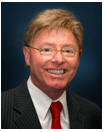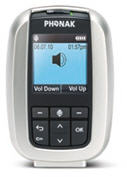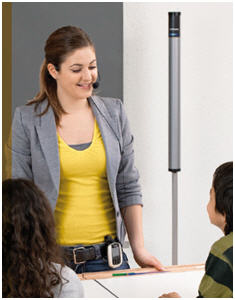Interview with Pat Henry, Director, Government Services, Wireless, and Pediatrics, Phonak
Topic: Phonak's Dynamic SoundField System

Pat Henry
CAROLYN SMAKA: This is Carolyn Smaka from AudiologyOnline and today I'm speaking with Pat Henry from Phonak. Pat, before we talk about the Dynamic SoundField system, would you review your background and your role at Phonak?

PAT HENRY: Sure. I've been in the industry for a little over 25 years. I started out in microelectronics working with FM and hearing aid products on the engineering and technical side and currently I'm managing Phonak's Government Services business, as well as our Pediatrics and Wireless business segments.
SMAKA: That's sounds like a big job! Thanks for taking the time to meet with me today.
Our topic today is the new Dynamic SoundField system. My first question is why did Phonak decide to go into soundfield systems at this time? I'm sure you've had plenty of requests over the years.
HENRY: Well, you're exactly right. We've been asked to get into the soundfield market for a long time, but we didn't want to come out with a product that didn't have significant advantages or benefits over the current systems. We have been the leader in personal FM systems;9 out of 10 children in the U.S. that use an FM system have Phonak receivers. In classrooms where soundfield systems and personal FM systems are used, audiologists have to take the FM transmitter and couple it into the soundfield system, or the teacher has to wear two transmitters. So entering the soundfield market seemed like an obvious next step. Back in 2007, we introduced a product called Dynamic FM that included a lot of world's-first technologies, and now we are able to bring these technologies to a soundfield system, with the new Dynamic SoundField system.
SMAKA: To take a step back, what are the benefits of soundfield systems in general?
HENRY: We know that classrooms are very noisy and that teachers are using their voice all day long. Some of the benefits of soundfield technology are that children's listening and learning skills improve, teachers repeat directions and information less often, amplification aids class instruction and management, and there's less vocal strain for teachers. There are a lot of studies out there that show these benefits. One that comes to mind was a MARRS (Mainstream Amplification Resource Room Study) Project that looked at mainstream amplification in the classrooms. It found many benefits. This project concluded that mainstream amplification in the classroom was not only beneficial for students with hearing loss, but also for those with normal hearing, developmental disabilities, chronic ear problems, and even for students who were using English as a second language. Students with minimal hearing loss, who are at risk of repeating at least one grade, show academic benefits with classroom amplification as well. Principals also notice fewer teacher absences due to fatigue and laryngitis. For all these reasons, we're seeing that soundfield systems are being embraced across the whole country, not only in special education, but in general education classrooms as well.
SMAKA: I think anyone who has been to a place where a soundfield system is in use, whether it's a place of worship, a community center, etc. notices the benefits immediately. You're at ease knowing that you're not going to have to strain to hear, you won't have to move your seat to view the speaker's face, or sit up front, etc.
HENRY: Exactly. One of the most powerful demonstrations I've seen is when somebody is talking into the microphone of a soundfield system, for example, in a place of worship, and then the microphone turns off. The speaker is still speaking but you notice a complete difference in how it sounds, and you may not be able to understand much at all.
SMAKA: You mentioned that the Dynamic SoundField system contains many of the world's-first technologies introduced in Dynamic FM. What are some of those technologies?
HENRY:
Right now, the big challenge with the current soundfield systems is the continuously changing noise level in the classroom. We all know noise levels in classrooms can be high, but we tend to forget that these noise levels also vary rapidly during the day. For optimal listening and learning a good signal to noise ratio is required. That means for higher noise levels in the classroom the gain of a soundfield system must be higher. But a high gain will be experienced as too loud and not comfortable to listen to during more quiet moments, where a lower gain is more appropriate. A low gain however will not give sufficient signal to noise ratios in noisier conditions. Any soundfield system with a fixed gain will offer only optimal benefit during a fraction of the day. Phonak's Dynamic SoundField is truly dynamic. It varies the gain depending on the noise level in the classroom, fully automatically. This will ensure good signal to noise ratios and at the same time optimal listening comfort independent of the background noise level. Noise levels are measured continuously by the soundfield microphone and the gain is adjusted accordingly. On top of that, if the microphone is not placed optimally and the voice of the teacher is picked up at a lower sound pressure level, an additional gain is applied to compensate for that, also automatically. Finally, we do not only alter the gain automatically, we also shape the frequency response depending on the noise level. At higher noise levels, which are often enhanced by reverberation in the classroom, we apply a high pass filter with a level dependent cut-off frequency. This will reduce the reverberant field which means we will reduce background noise. Another effect is that less amplification of low frequencies puts emphasis on higher frequencies, where more speech information is available and upward spread of masking is reduced at the same time.
Another big challenge for soundfield systems is feedback. The Dynamic SoundField system has been designed to eliminate feedback problems once and for all. The design of the new microphone, the design of the loudspeaker unit, plus two very advanced feedback cancellation algorithms in the time and in the frequency domain all operate towards this end.
SMAKA: For students using FM in the same classroom how does this work for the teacher?
HENRY: The majority of the FM transmitters in use are Phonak inspiro transmitters, and they are Dynamic FM transmitters. Inspiro transmitters operate in the 216-217 MHz frequency band. So we've taken the existing inspiro transmitter, made some significant enhancements to the firmware, and enabled it to become a dual analog/digital device via a simple upgrade. Now, the existing inspiro can transmit to students that are using FM in the 216-217 MHz frequency band, and also to the Dynamic SoundField system that is operating digitally in 2.4 gigahertz frequency band in a frequency-hopping technology. We have looked at various wireless transmission technologies currently in use for soundfield systems. They all have very serious drawbacks, like interferences, dead spots and so on. We decided we need a totally new wireless technology to overcome all drawbacks. The new wireless technology we call DM, which stands for Digital Modulation. It offers the following benefits: excellent operating range, no interferences from other soundfield systems or any appliances like lighting, computers, Bluetooth or Wifi, no need for frequency planning or frequency allocation, no dead spots, no line of sight required between transmitter and loudspeaker, and an excellent audio sound quality in terms of audio bandwidth and system signal to noise ratio. On top of that, DM is a bidirectional communication technology, so the transmitter continuously monitors the integrity of the loudspeaker unit. DM also offers the MultiTalker Network, so the DynaMics - the pass around microphones for inspiro - can also be upgraded to become Dynamic SoundField transmitters.

A free firmware upgrade turns the inspiro FM transmitter into a Dynamic SoundField transmitter as well.
SMAKA: So, if I have an inspiro transmitter how does the upgrade work?
HENRY: Existing Phonak inspiro transmitters can be upgraded to include full Dynamic SoundField functionality for free. It's a firmware upgrade that turns the inspiro FM transmitter into a Dynamic SoundField transmitter as well. The beauty is that once the inspiro has the Dynamic FM firmware upgrade, it can operate in FM only, in Dynamic SoundField only, and it can operate in both FM and SoundField modes simultaneously.
SMAKA: Wow, you guys have thought of everything. So you just hook it up to your computer and upgrade it?
HENRY: Exactly through FM SuccessWare 4.5.
SMAKA: We've talked about the transmitter, what about the speakers? How many speakers need to be set up around the classroom?

The Dynamic SoundField system features an innovative new super directional loudspeaker array that consists of 12 individual high-quality, loudspeakers. Housed in a robust aluminum frame, the array can stand on the floor or be wall mounted.
HENRY: This system has a super directional 12-loudspeaker "array" - 12 high quality speakers on one robust aluminum unit. The unit can just be set on the floor and plugged in and it's good to go, or it can be wall mounted. It covers a large area with a clean, high-quality signal. The clever design of the loudspeaker array gives it unique acoustical properties, not found in any other loudspeaker. This helps children hear comfortably, wherever they are seated in the classroom. One loudspeaker unit is all you need for a classroom.
SMAKA: Plug it in and go? I assumed installation would be required?
HENRY: No installation is needed. There are no complex on-board settings to adjust. It's really plug and play, or as we like to say, Plug, Play and Teach.
SMAKA: Ok, I'm just speaking for myself here, but this system seems dummy-proof.
[laughter]
HENRY: We designed this system to be easy and convenient to use. You know, complexity can lead to inadvertent misuse of classroom amplification, which can worsen rather than improve the sound in classrooms. Simplicity was important to us in developing this system. We have put the scientific knowledge of audiology and classroom acoustics in the system itself, making the system intelligent and automatic.
On that note, the system also has data logging via the FM Successware. Successware is software that is used with the inspiro transmitter. With data logging, the educational audiologist can see the use of the transmitter if it's being used in Dynamic FM. Data logging will also display the noise level in the classroom every 15 minutes, and some other amazing things that can best support the teacher and students in that classroom.

Dynamic SoundField system in use.
SMAKA: Pat, are any sites currently using a Dynamic SoundField system, perhaps in a beta-test or early release?
HENRY: Yes, we have a validation process whereby after the product is manufactured we put it in many classrooms throughout the United States. The results have been dramatic. The beauty of the system is that the setup is so simple. You basically plug it in and turn it on. The transmitter measures the acoustic impedance in the classroom and it automatically adapts to the right sound level. Unlike other systems that have confusing frequency and volume adjustments - and often need re-adjustment - this one is truly plug and play.
When we put these into the classrooms, the teachers were just amazed. One teacher with years of soundfield experience said: "Dynamic SoundField has been wonderful. The students are really staying focused during lessons and when I forget to turn it back on they are quick to remind me. I think this is the best system I have had the opportunity to use over my 20 years teaching" And that is just one example, we have many more. We had really good results and the students did not want us to take them out of the classrooms. So we couldn't be more pleased with the success of the validation.
SMAKA: Where do audiologists get training or more information about Dynamic SoundField system?
HENRY: Good question. A big part of what we do at Phonak is to make sure we always provide the highest level of information and training for our products. The first place I would direct audiologists for information on the Dynamic SoundField system is www.dynamicsoundfield.com. We also have our special website www.eschooldesk.com dedicated to providing support for our FM products.
The sites include short movies, troubleshooting advice, set up procedures, and all of the things one would need. There's a movie on Dynamic SoundField that's very informational.
We also have a support team called the School Desk. They're a group of specialists that work with FM and pediatric solutions to support educational audiologists. We also have a strong pediatric team headed by Christine Jones, and they are all experts in amplification and education as well.
In addition, we have a recorded course on AudiologyOnline, Discover Dynamic SoundField.
SMAKA: Thanks for your time today, Pat. Wishing you much success with the system, and with all the hats you're wearing! Hope we can catch up after the product release and hear about how it's going.
HENRY: We have outstanding leadership teams at our wireless and hearing aid product headquarters in Murten and Stafa Switzerland and at our Phonak USA headquarters. We're all excited about the new Dynamic SoundField system, and the tremendous benefits it will provide to our nation's students and teachers. Carolyn, we would welcome the opportunity in six months to give you an update and share what we've learned. It should be interesting and a lot of fun.
SMAKA: Yes, that'd be great. Thanks again.
For more information, visit www.Phonak.com or the Phonak web channel on AudiologyOnline.

